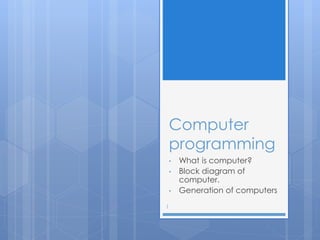
Computer programming1
- 1. Computer programming • What is computer? • Block diagram of computer. • Generation of computers 1
- 2. What is computer ? Computer is an electronic machine that takes input (data) analyze it process it and give the desired output (information ). Also provide the capability of storing data for future use. 2
- 3. Block diagram of computer 3
- 4. CPU Central Processing Unit Responsible of all kind of processing. Process the data according to the set of instruction given by the user. Three major parts of CPU - Control Unit - Registers - ALU ( Arithmetic and Logical Unit ). 4
- 5. Control Unit Read instruction from the memory , decode it and send signal to various parts of computer to perform the work accordingly. Control the sequence of instruction to be executed. 5
- 6. Registers Store intermediate results during program execution. Made up of flip- flop. Categorize in two types - General Purpose Register - Dedicated Register 6
- 7. ALU Arithmetic Operations ( +,-,/,%,*….etc) Logical Operation( Comparission ). 7
- 8. Memory Unit RAM Secondary Storage 8
- 9. Input and Output Devices Mouse, keyboard…etc Monitor, printer…etc 9
- 10. Generation of Computer Basically 4 generation of computer development. I Generation ( 1940 - 1956 ) :- vacuum tubes. - Very big and bulky. - Heating effect. - Large electricity consumption. - Work on 0’s and 1’s. - Machine Dependent. - Magnetic drum for storage. - Input through punch card and output through printers. Example :- UNIVAC, ENIAC 10
- 11. 2nd Generation of Computer II Generation (1957-1963) Transistors. - Very small in size as compare to vacuum tube. - Smaller in size, cheap, much more energy efficient. - Magnetic core technology is used instead of magnetic drums. - Assembly Language instead of binary. - Translators required. - Input still taken by punch card and output by printouts. - Programming is machine dependent. Examples:- PDP-8, IBM 1401 and CDC 1604. 11
- 12. 3rd Generation of Computer III Generation (1964-1971) Integrated Circuits ( ICs ) - Size of computer more compact, more energy efficent. - Speed of computation become very high. - SSI and MSI is used. - Use of High Level Languages(COBOL, PASCAL FORTRAN, BASIC…etc) - Programming Languages are machine independent. - Keyboards and mouse - input and monitors - output. - Multiple task . Examples:- IBM 370, PDP 11,IBM-360 series,Honeywell-6000 series. 12
- 13. 4th Generation of Computer IV Generation (after 1971) Microprocessor - VLSI - Compact and light in weight, consume less energy. - Very fast processing speed. - Multitasking is possible. - High level language is used such as C/C++, java…etc. - Time-sharing , real time, and distributed operating system. Example :- IBM system 3090, HP 9000 13
- 14. 5th Generation Computer Artificial Intelligence, Parallel programming ULSI ( Ultra Large Scale Integration ) 14
Notas del editor
- http://www.notes99.com/2014/03/generation-of-computers.html
- http://www.notes99.com/2014/03/generation-of-computers.html